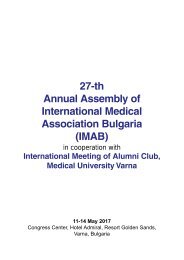JofIMAB-2016-vol22-issue3
You also want an ePaper? Increase the reach of your titles
YUMPU automatically turns print PDFs into web optimized ePapers that Google loves.
3. Positron Emission Tomography Scanners (PET scanners)<br />
Positron Emission Tomography Scanners (or positron<br />
emission tomography) are diagnostic imaging devices that<br />
display biochemical and physiological changes and diagnose<br />
a disease at a very early stage before any morphological<br />
changes have occurred. This makes them different from<br />
MRI and CT devices that register structural anatomical<br />
changes that have already appeared in organs [15, 16]. In<br />
addition, they are used to monitor the effects of antitumor<br />
therapy. A disadvantage is their high price when compared<br />
to other diagnostic imaging tests: 2800 BGN, now entirely<br />
covered by NHIF, registration being subject to approval by<br />
a special medical committee. The first PET scanner was introduced<br />
in Bulgaria in 2009 at Sv. Marina University Hospital<br />
in Varna. Gradually their number increased and by <strong>2016</strong><br />
there were 3 hospitals operating PET scanners: Sv. Marina<br />
University Hospital in Varna, Sv. Georgi University Hospital<br />
in Plovdiv and Aleksandrovska University Hospital in<br />
Sofia.<br />
As seen from the graph the countries covered by the<br />
study that have the greatest number of PET scanners per<br />
capita are Belgium – 26.76 devices per 1 million people,<br />
Denmark – 6.03, Japan – 4.34, etc. (Fig.3.)<br />
To operate, PET scanners need a specific radioactive<br />
isotope consumable called radionuclide fluorine-18. In <strong>2016</strong><br />
Bulgaria had 2 cyclotron sets for their manufacturing: in Sv.<br />
Marina University Hospital in Varna and Aleksandrovska<br />
University Hospital in Sofia. A third set is to be constructed<br />
in INRNE (Institute for Nuclear Research and Nuclear Energy)<br />
at BAS (Bulgarian Academy of Sciences) – Sofia by the<br />
end of 2017. A cyclotron set consists of a mini cyclotron device<br />
producing individual doses of radioactive isotopes for<br />
about 180–200 patients a month. It guarantees constant availability<br />
of the PET scanner consumable. Until then isotopes<br />
for PET scanners will be delivered by air due to their short<br />
period of decay [17, 18].<br />
The radiopharmaceutical most applied is 18F<br />
Fludeoxyglucose (F18 FDG). It is a substance analogous to<br />
glucose used in PET and suitable for testing metabolism of<br />
glucose in the heart, lungs and brain. It is also applied when<br />
monitoring treatment of Hodgkin’s disease, non-Hodgkin’s<br />
lymphoma, colorectal cancer, breast cancer, melanoma, lung<br />
cancer, etc. [19, 20].<br />
Fig. 3. PET scanners worldwide in<br />
2009.<br />
1192 http://www.journal-imab-bg.org / J of IMAB. <strong>2016</strong>, vol. 22, issue 3/



